Preparedness Challenge Week 12
Thanks for joining the 2022 Preparedness Challenge!
This week the challenge is to add extra containers of yeast and other leavenings to your pantry. In a time of crisis, you may need to rely more on foods prepared at home. Breads and other baked goods require leavenings, so it’s good to have a supply in your food storage.
This week, add back-up containers of yeast, baking soda, and baking powder to your food storage.
What Types of Yeast Are Best for Preparedness?
Yeast is a single-celled microscopic organism that thrives in a warm, moist environment. The yeast cells consume sugar and give off carbon dioxide and ethanol. The carbon dioxide helps bread rise and the ethanol adds flavor and aides in the bread rising. Yeast for baking comes in three forms: active dry yeast, instant yeast, and fresh yeast.
ACTIVE DRY YEAST
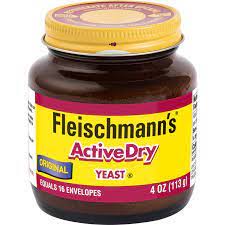
Active dry yeast is the most popular yeast for home bakers. It is found in ¼-ounce packets and 4-ounce tinted jars at the grocery store. Use active dry yeast for a steady rise in dough and in recipes that call for a double-rise period. A slow rise will develop more subtle flavors in all types of yeast dough. According to Red Star Yeast Company, active dry yeast can be used successfully either by activating it first in warm water before adding it to the dough or by adding it directly to dry ingredients. If it is added directly to dry ingredients, the liquid should be very warm—120 to 130 degrees F.
INSTANT YEAST
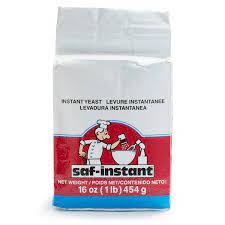
Instant yeast has smaller granules than active dry yeast which helps it activate quickly. It is reliably consistent and more shelf-stable than active dry yeast and is intended to be added directly to the dry ingredients. It is best for recipes that require only one rising or to raise dough if you are in a hurry. But it is not as good for slow-rise recipes and may sacrifice flavor.
FAST-ACTING YEASTS
Fast-acting yeasts are a subset of instant yeast. They are designed for one rising and do not do well in recipes that call for a long, slow rising or in refrigerator doughs. Bread-machine yeast is another fast-acting yeast.
FRESH YEAST
Fresh yeast, also called baker’s yeast, comes in compressed cakes, is somewhat temperamental, and must be dissolved in warm liquid. It is fast acting but is also extremely perishable, lasting only two to four weeks. It is offered in limited markets and usually only available seasonally. Some professional bakers like it for traditional bread recipes because it gives the bread a rich, hearty flavor. It’s short shelf life makes it unsuitable for food storage.
Can Active Dry Yeast and Instant Yeast Be Used Interchangeably?
Active dry yeast and instant yeast can be used interchangeably. However, dough made with active dry yeast will likely take longer to rise. But bread made from longer-rising dough may have a subtle, richer flavor. Instant yeast does not need to be proofed and can be added directly to the dry ingredients. You can substitute with this ratio:
- 1 teaspoon of active dry yeast = ¾ teaspoon of instant yeast
- 1 teaspoon of instant yeast = 1¼ teaspoon of active dry yeast
What Is the Storage Life for Yeast?
Manufacturers recommend a best-if-used-by date of two years for both active dry yeast and instant yeast. However, if it is stored in a cool, dry place, the storage life can be much longer. Yeast stored in the freezer in an airtight container will have the longest storage life. Active dry yeast is more fragile and susceptible to high temperatures, whereas instant yeast is more shelf-stable.
Keep it Simple: Store an extra 16-ounce package of instant yeast in your freezer.
TEST YEAST VIABILITY
Test to see if yeast is still viable by sprinkling a small amount in a half-cup of warm water (100-115 F) with a teaspoon of sugar. If the yeast is viable, within ten minutes it will bubble and give off a yeasty aroma.
What Is the Best Way to Purchase Yeast?
Yeast typically comes in ¼-ounce packets, 4-ounce jars, or one-pound blocks. The best value is the one-pound blocks. Once the vacuum packages are open, store the yeast in mason jars in the refrigerator or freezer.
How Much Yeast Should You Store?
One pound of Saf Instant Yeast will make 96 loaves of bread. A typical American eats 60 loaves of bread in a year. At that rate, a family of four would need about 2½ pounds of yeast for a year of bread making.
Determine how many loaves of bread you might potentially make in a crisis and for each 100 loaves of bread, store one pound of yeast. For long-term emergency storage, you may want one-half to one-and-a-half pounds of yeast per person.
Should I Store Something I Don’t Use?
Maybe you don’t use very much leavening in your typical food preparations, so you are wondering if it is a waste of money and effort to store leavenings. So, what is the solution? First, consider that you may need them in case there is a crisis where you need to use food preparation strategies that include more made-from-scratch baked goods.
Second, think about storing things like leavenings and other things you don’t frequently use as “insurance.” We pay insurance premiums for all kinds of potential loss, hoping that we won’t have to file a claim. In the case of leavenings, they aren’t very expensive, so it’s a good idea to add them to your storage.
A Strategy for Keeping Your Food Storage Up-to-Date
One strategy for storing leavenings is to have one of each kind that you keep for immediate use in your kitchen. Then keep two additional containers in your storage area. In the case of yeast, keep it in your freezer. When you have used all the leavening in your kitchen or when it declines in potency, replace it with one from your storage. Then at the next opportunity, add a new container to your storage. That way you will always have two of each kind of leavening.
What Can You Do When Yeast Is in Short Supply?
USE LESS YEAST
Many yeast-bread recipes call for more yeast than is necessary. If you need to conserve yeast in an emergency, you can use one-half to one-fourth the amount of yeast called for in typical yeast-bread recipes. It will likely take longer for the bread to rise, but it may also enhance the flavor of the bread.
If you live several thousand feet above sea level, you need less yeast than recipes typically call for to make good-quality bread. The Utah State University Cooperative Extension has an excellent bread-making pamphlet, Enjoy Yeast Breads, both Plain and Fancy, by Elna Miller and updated by Georgia Lauritzen, to help you adjust bread making for higher altitudes.
EVERLASTING YEAST
Another strategy is to make your own “everlasting” yeast starter. Typical starters are made with flour, a boiled potato and its water. Some starters add a bit of sugar or commercial yeast to help get the fermentation going. The idea is to use the starter to make bread, reserving a portion, called the leaven, to use in a later batch. This way the start is “everlasting.” It’s a good idea to have two starts in case you accidentally lose one.
SOURDOUGH STARTERS
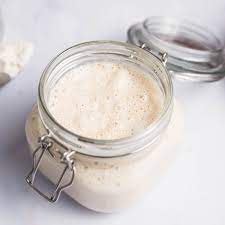
Sourdough starts are another way to have an ongoing rising agent for bread and other baked goods. It is made with wild yeast found naturally all around us, whole wheat and white flour, water, and a bit of patience. This starter works much like the everlasting yeast starter where you reserve a portion to “feed” and use later.
Tips for Using Chemical Leavenings in a Crisis
Baking Soda
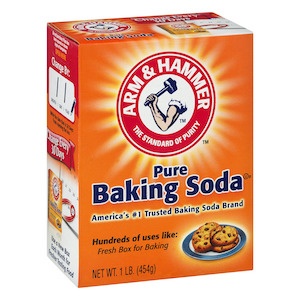
Baking soda acts as a leavening and activates when combined with liquid and acid. This is why baking soda is found in baked goods made with buttermilk or lemon juice. Carbon dioxide bubbles are released which helps make baked goods light and fluffy.
SHELF LIFE OF BAKING SODA
If stored in a cool, dry location baking soda has a shelf life of three to five years. Store it in an airtight container to prevent contamination from moisture. It may remain potent longer if it is kept cool and dry.
HOW TO TELL IF BAKING SODA IS “GOOD”
Test baking soda’s potency by adding a half teaspoon of vinegar to a tablespoonful of the baking soda. It should foam and bubble.
HOW MUCH BAKING SODA SHOULD YOU STORE?
Baking Soda is inexpensive, so store plenty. Besides leavening, it is useful as a dentifrice toothpaste, deodorant, cleaner, fire extinguisher, and for first aid. Store two tor more pounds per person in an airtight container. Label with the date and check potency periodically.
Baking Powder
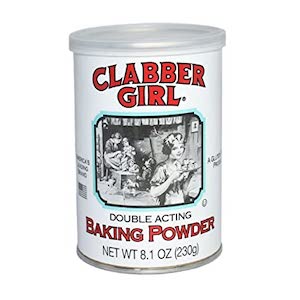
Baking powder is a combination of baking powder and dry acid. It is used in recipes that do not have other acidic ingredients. Most baking powder is double acting, which means it acts first when it is wet and then again when it is heated.
SHELF LIFE OF BAKING POWDER
Baking powder is sensitive to both heat and moisture and has a shelf life from a year to eighteen months. Storing sealed cans in a cool dry place will increase their shelf life. Check its potency periodically and replace as needed.
HOW TO TELL IF BAKING POWDER IS “GOOD”
Test whether baking powder is still good by pouring a quarter cup of boiling water over a half teaspoon of baking powder. It should actively bubble up.
SUBSTITUTES FOR BAKING POWDER
You can substitute baking soda for baking powder with a few changes. First, baking soda is three times more potent than baking powder, so you need one-third as much. Baking powder has an acid component, so you will need to add extra acid to help activate baking soda. Add one teaspoon of lemon juice or vinegar for each half-teaspoon of baking soda.
- 1 tablespoon of baking powder = 1 teaspoon of baking soda plus 2 teaspoons of cream of tartar
You can also make your own baking powder using one-part baking soda and two-parts cream of tartar. Be aware that this mixture is not double-acting like regular baking powder, so it starts working as soon as liquid is added. Add one-part cornstarch if you are going to store the mixture.
Cream of Tartar
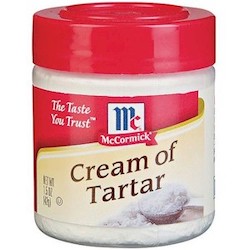
Cream of tartar is an acid with leavening properties when combined with baking soda. It is also helpful in stabilizing whipped egg whites and in controlling the formation of sugar crystals in candy. Lemon juice can be used in place of cream of tartar. Store several jars as back-up.
HOW TO TELL IF CREAM OF TARTAR IS “GOOD”
Cream of Tartar is a powdered acid and has a very long shelf life. It must be properly stored in a container with a tight-fitting lid to prevent it from being contaminated by moisture. Cream of tartar will be hard and clumpy when it has lost its effectiveness.
Learn More
Find out more about storing foods in Crisis Preparedness Handbook, Third Edition (2020). If you don’t already have a copy, you can find it here on my website CrisisPreparedness.com. Or, read it on Amazon in the Kindle version or hard copy version.
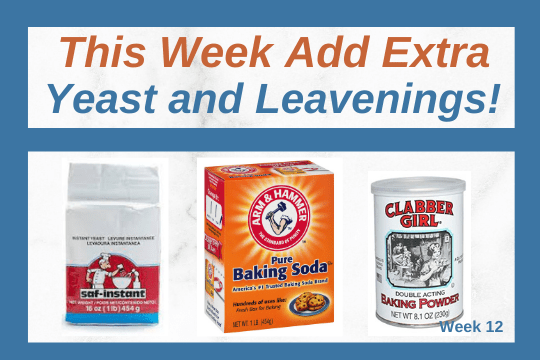



12 thoughts on “Add Extra Yeast and Leavenings to Your Pantry”
Thank you so much for your willingness to share your expertise. I keep passing on and on all the knowledge I learn from you and my friends love it.
I am one of those friends, and I have already passed it on to another!
Thank you! I am glad it is helpful!
Thank you so much! I am glad you are finding it worthwhile!
Thanks! I learned a lot there! Question – is baking powder without aluminum as effective as with aluminum? Is it used any differently?
I honestly don’t know. I don’t have any experience with non-aluminum baking powder.
Thank you so much for the great information! You are helping me think of what to add to my storage. I really appreciate it!
Thanks so much for you kind words. Glad it is helpful.
How many weeks will this be going on
The 2022 Preparedness Challenge will last for all 2022. It is published weekly on Monday at 6:00.
Superb layout and design, but most of all, concise and helpful information. Great job, site admin. Take a look at my website QU9 for some cool facts about Thai-Massage.
I know a lot of folks whom I think would really enjoy your content that covers in depth. I just hope you wouldn’t mind if I share your blog to our community. Thanks, and feel free to surf my website UY8 for content about E-Book Marketing.